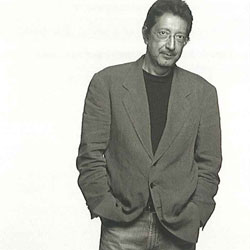Julião Sarmento
Julião SarmentoLisboa ¶ 1948
 |
|
| Créditos fotográficos / Photographic credits: Abílio Leitão |
After graduating in Architecture at the Fine Arts School of Lisbon (1967-1974), he began his career as a painter and today he is one of the most firmly internationalised Portuguese artists. ¶ After a pop-inspired figuration phase and post-conceptual practices, mainly on film, to which he has returned in more recent years, he is known above all as a painter, intimately related to the 80s generation "back to painting" trend, the decade in which the artist achieved his first international recognition with his participation at two Documentas (Kassel, Germany, 1982 and 1987). ¶ As a painter, Sarmento uses very different assets, juxtaposing popular and erudite references. The resulting effect bifurcates towards two universes, literature and cinema, the very two structural axes of his whole work. ¶ In its early stage, Sarmento's painting juxtaposes, on the one hand, fragments, images of glamour and violence, and on the other hand, the word, which takes the role of a caveat. Likewise, it explores the imagetics of the unconscious and the disturbing nature of intermissions in representation. ¶ With the transition from the 80s to the 90s, his painting becomes more sober and restrained, achieving a monastic-like depuration, a phase known by an all-encompassing designation, Pinturas Brancas (White Paintings) in which graphite over white canvas drawings are predominant. At the same time, this stage concurs with Sarmento's consecration, as he is the Portuguese representative at the 1997 Venice biennial. ¶ The representation of the feminine body, which had always been present - if not comprised his own brand image - reaches a new level of subtlety and allusion. Making his stock-in-trade "interrupted drawings" more explicit, the artist pursues his unquenchable search for harmonizing the task of visual creation and invention with the discovery of the territories of formulating and questioning desire in its infinite modulations.
http://cvc.instituto-camoes.pt/biografias-en/juliao-sarmento-19859.html#sigFreeId3b1f74ba82


